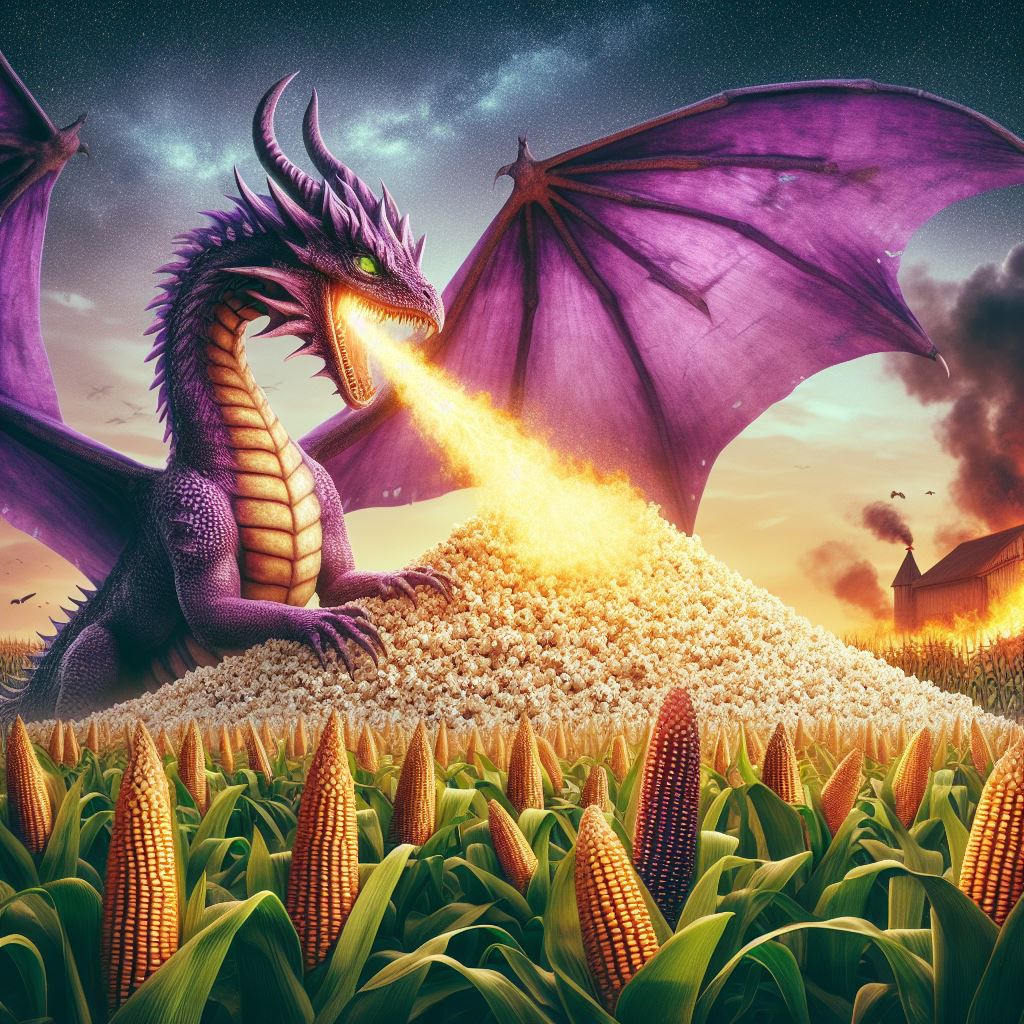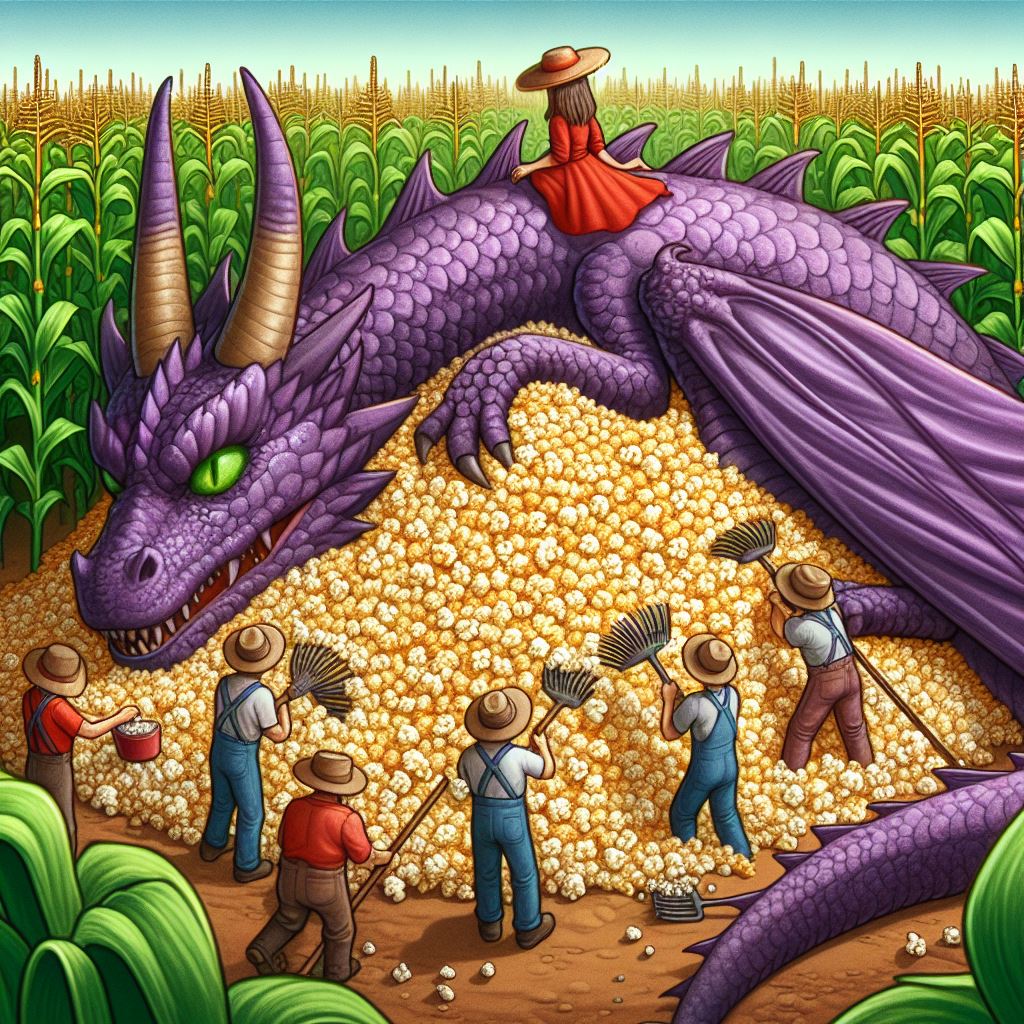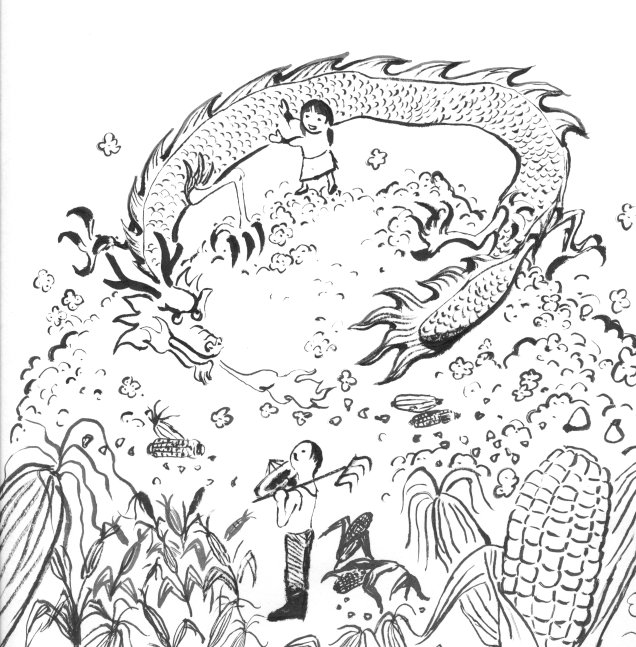The Purple Dragon
by Karl Schmidt (C)1984
Once upon a time, in a land far far a way, lived a
grand purple dragon. He spent his days in his cave on an island of
sea guarding his family jewels (as that is what dragons do).
One day, he started to itch in the middle of his back in that
place where you can't quite reach. The itch got worse and
worse until he started to sweat! Now sweating is very a bad thing
for dragons, for if they start to sweat, their scales will fall
off and dragons need their scales!
The purple dragon knew he would have to get help, so he went out
of his cave and jumped into the air and began to fly. He flew a
long time over the ocean all the time itching so bad that he was
really beginning to sweat now!
Finally, he saw land ahead, and he flew over and saw a little girl
standing in a corn field that looked just like you! He went
down and landed, bowed to the girl and told her that he needed her
help.
"You see I have an itch in the middle of my back in that place
where you can't quite reach. Can you help me scratch it?"
The little girl was a little scared, as she had never seen a
Purple dragon before (actually she had never seen any dragons
before)! She told the Dragon with a bit of a waver in her voice,
"I will try, but I am so small I don't think I can quite reach."

At that point, a farmer saw the dragon and was very afraid - so he
called his friends and they came towards the dragon swinging their
shovels, rakes, and pitchforks. The dragon backed slightly
and took a deep breath and blew out a great ball of fire.
The farmers ran away, dropping their rakes and shovels, but the
ball of fire hit the corn in the field, and because it was a field
of popping corn, it popped (and made a lot of noise!) - so much
popped that there was now a small hill of freshly popped popping
corn.
Then the little girl, who looks just like you, had an idea. She
grabbed one of the rakes and climbed up the hill of freshly popped
popping corn and called to the dragon to come next to the hill.
Now she could just reach with the rake and scratch the dragon in
the middle of his back in that place where you can't quite
reach.
 The dragon was so relieved now that the itch was gone.
He bowed again to the girl, who really looked just like you, and
politely thanked her. He told her he would always be her friend
and the girl smiled from ear to ear. Then the dragon said he
must get back to his cave and the girl asked if he really must
leave so soon. He told her that he must, for the farmers would
come back and he really didn't want to hurt them, besides he had
to guard his jewels. He said he only had time to give her a short
ride if she liked. So she climbed up the hill of freshly popped
pop corn and got on the dragons back and the dragon ran a few
steps and off they flew as she held on tight.
The dragon was so relieved now that the itch was gone.
He bowed again to the girl, who really looked just like you, and
politely thanked her. He told her he would always be her friend
and the girl smiled from ear to ear. Then the dragon said he
must get back to his cave and the girl asked if he really must
leave so soon. He told her that he must, for the farmers would
come back and he really didn't want to hurt them, besides he had
to guard his jewels. He said he only had time to give her a short
ride if she liked. So she climbed up the hill of freshly popped
pop corn and got on the dragons back and the dragon ran a few
steps and off they flew as she held on tight.
The girl squealed with delight as she looked down and waved at the
people that looked like ants from up so high. The dragon came back
and the girl climbed back onto the hill of freshly popped pop corn
and waved good by as the dragon took to the sky and returned to
his island in the sea.
Now at night, the little girl dreams of riding on the back of her
friend, the purple dragon.
The end.
Some notes on the purple subspecies of Asian dragons:
There are five species of Asian dragons known: Draconis
rubeus (the Red dragon), Draconis aurum (the
gold dragon), Draconis thalassinus (the
green dragon), Draconis sapphirus (the blue dragon) and Draconis
purpura (the purple dragon). Dragons are related to
cephalopods, giant squids in particular. Like most molluscs,
cephalopods use hemocyanin, a copper-containing protein, rather
than hemoglobin to transport oxygen. At some point there was a
mutation that gave dragons a much more effective red blood
with a very similar molecule to hemoglobin that is thought to
be why they were able to develop such high intelligence.
While some biologists disagree, the rare purple dragon breed is
thought to be result of a hybrid cross between the red and the
rare blue Asian dragons species that were bred to protect castles.
The winged European dragons, Draconis alaruos are
thought to have descended from the Asian blue dragons. The
Asian blue dragon, has recently been shown by DNA evidence to have
been bred from the red during the early Ming dynasty putting an
end to a long and ugly controversy by past dragon paleontologists
over thoughts that it had come from the diminutive green dragons
genes. A breeding back to the original red dragon is thought
to be the source of the largest and most intelligent of the
dragons, the rare purple dragons. (By the way, the very
dangerous gold dragon was almost as long, but lacks any hint
of the purple dragons advanced intelligence.)
Why the European dragons lost their levocorpus or had non
functional ones is highly controversial, some think it had to do
with the different diet available on the European continent, while
others insist that it was due to the evolution of much larger wing
buds - the Asian dragons don't always even have this structure.
Still others insist the winged dragons are a completely different
species descended from giant bats.
Little is know about the purple dragons other than their
incredible length, their amazing intelligence and speech
ability. We also know that they had the largest known of the fire
producing organs (called the incendio gland) of any dragon, .
Non winged, the purple dragon had the most well developed
levocorpus of any dragon which extended over 180 degrees so that
most of the sides could also produce lift. This is thought to
explain the highly maneuverable body.
The purple dragons hybrid vigor and intelligence was coupled with
a rather low fertility rate which is thought to have limited the
species along with the violent and sometimes lethal mating
courtship. The purple dragons mated for a lifetime - now thought
to be over 800 years!
While the purple dragon mostly believed to be extinct like the
other dragons, occasional sightings are still reported and it is
possible that this elusive dragon my still be with us. The
extinction of dragons during the middle ages is thought to be from
over hunting. The hide of dragons produced better armor than
leather, but unfounded myths of the properties of 'heart stings'
caused countless dragons to be slaughtered only to find inside
their bodies a heart not unlike those in cephalopods. 
(C) Copyright 1984-2024

 The dragon was so relieved now that the itch was gone.
He bowed again to the girl, who really looked just like you, and
politely thanked her. He told her he would always be her friend
and the girl smiled from ear to ear. Then the dragon said he
must get back to his cave and the girl asked if he really must
leave so soon. He told her that he must, for the farmers would
come back and he really didn't want to hurt them, besides he had
to guard his jewels. He said he only had time to give her a short
ride if she liked. So she climbed up the hill of freshly popped
pop corn and got on the dragons back and the dragon ran a few
steps and off they flew as she held on tight.
The dragon was so relieved now that the itch was gone.
He bowed again to the girl, who really looked just like you, and
politely thanked her. He told her he would always be her friend
and the girl smiled from ear to ear. Then the dragon said he
must get back to his cave and the girl asked if he really must
leave so soon. He told her that he must, for the farmers would
come back and he really didn't want to hurt them, besides he had
to guard his jewels. He said he only had time to give her a short
ride if she liked. So she climbed up the hill of freshly popped
pop corn and got on the dragons back and the dragon ran a few
steps and off they flew as she held on tight.